Pateley Bridge, Yorkshire
Up to 1834
Pateley Bridge had a small parish workhouse to the east of the town beyond Church Green, on the hillside above the Knott. Low poor rates in the area, and lack of work to provide for inmates meant that it was never heavily used, although 14 parishes contributed twice a year towards its upkeep.
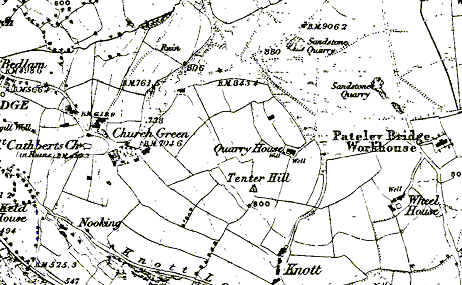
Pateley Bridge Knott site, 1850s.
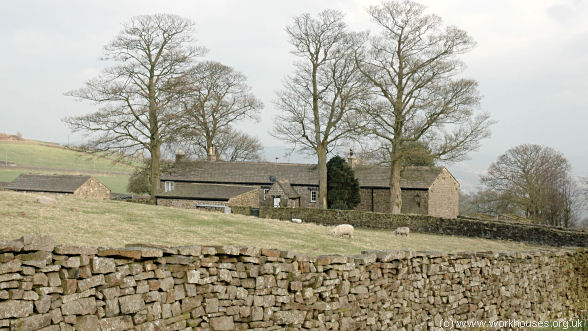
Pateley Bridge former Knott workhouse, 2006.
© Peter Higginbotham.
After 1834
Pateley Bridge Poor Law Union was formed on 15th February 1837. Its operation was overseen by an elected Board of Guardians, 17 in number, representing its 10 constituent parishes as listed below (figures in brackets indicate numbers of Guardians if more than one):
West Riding of Yorkshire:
Bewerley (3), Dacre (2), Fountain's Earth, Hartwith with Winsley (2), High and Low Bishopside (3), Menwith with Darley (2), Thornthwaite with Padside, Thurscross, Down Stonebeck, Upper Stonebeck.
Later Additions: Birstwith (from 1854), Bishop Thornton (from 1854), Clint (from 1854), Warsill.
The population falling within the Union at the 1831 census had been 7,686 with parishes ranging in size from Thornthwaite with Padside (population 304) to High and Low Bishopside (1,849).
Like a number of other Yorkshire Unions, Pateley Bridge resisted the building of a new central workhouse, preferring instead for parishes to make local arrangements and to obtain pauper accommodation on a contract basis as required. Children, for example, were sent to the Leeds Moral and Industrial School.
A new Union workhouse was eventually erected in 1862-3 at Pateley Bridge near St Cuthbert's Church. It was designed by John and William Atkinson who were also the architects of many other Yorkshire workhouses including those at Bedale, Beverley, Easingwold, Goole, Guisborough, Helmsley, Howden, Kirkby Moorside, Pocklington, Skirlaugh, Wetherby and York. The workhouse location and layout are shown on the 1907 map below.
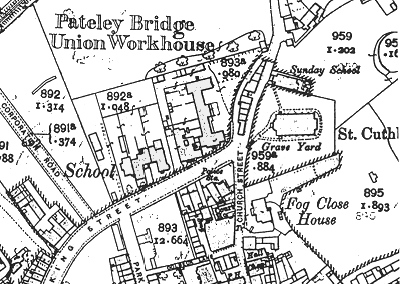
Pateley Bridge site, 1907.
The workhouse was finally occupied in November 1863. The first Master and Matron were John Thompson and his wife Elizabeth who received salaries of £18 and £12 per annum respectively.
The workhouse's main building had an H-shaped layout with its entrance at the south.
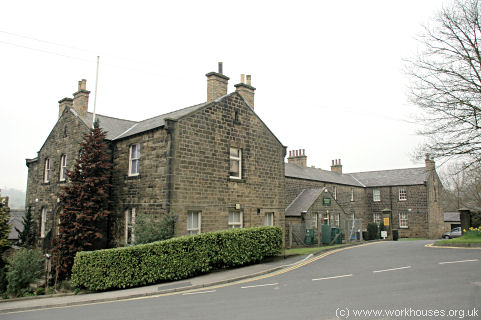
Pateley Bridge main building from the south-east, 2000.
© Peter Higginbotham.
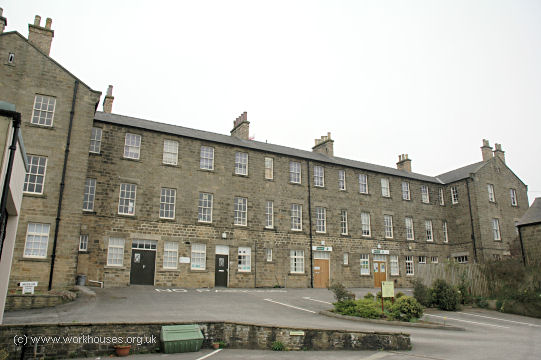
Pateley Bridge main building from the west, 2000.
© Peter Higginbotham.
A block at the south-west of the main building probably contained the Guardians' board-room, together with receiving wards and casual wards.
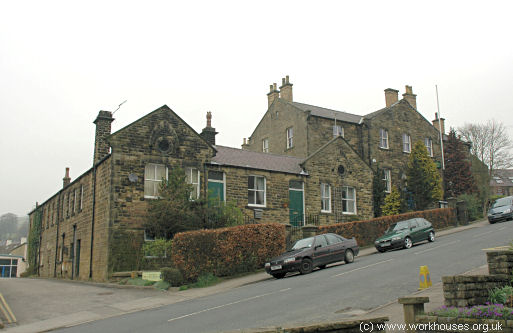
Pateley Bridge from the south-west, 2000.
© Peter Higginbotham.
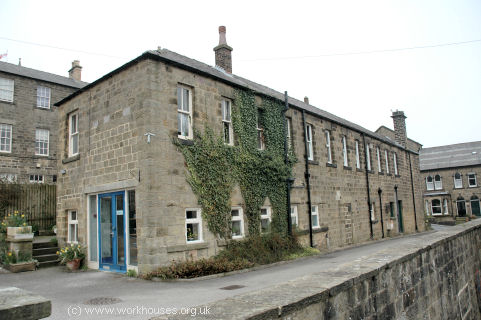
Pateley Bridge casuals' block from the north-west, 2000.
© Peter Higginbotham.
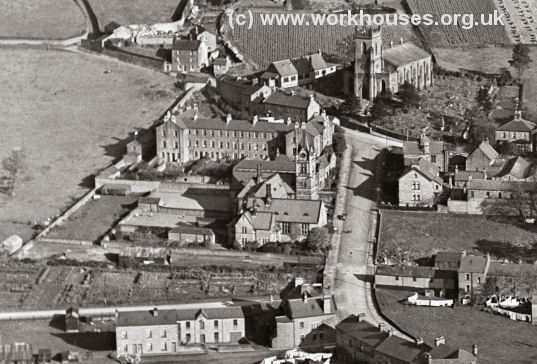
Pateley Bridge aerial from the west, c.1920s.
© Peter Higginbotham.
An appraisal of the recently opened workhouse came in the form of a report in 1866 by Poor Law Board Inspector Mr HB Farnall:
The site of this workhouse is suitable, but, as it seems to me, it would have been good policy on the part of the Guardians to have purchased a rather larger site, so as to have given them the means of enlarging the house at any time.
The accommodation for the several classes of inmates is sufficient, but the floors of the receiving wards are of stone, and the walls of the house are damp in several of the wards. Provision is made for separating infectious eases from other sick inmates, but the walls of these detached wards are so damp that they are at present unfit for use.
There ate no separate sick wards for children.
The ventilation, water supply, light, and the sanitary state of the house are satisfactory. The beds, bedding, and utensils are sufficient, hut there are no taps of hot water in the sick wards, and a bath room for the children is wanted.
The classification of the inmates is not complete, for the children and the adult women are not strictly classified by day; the diet, clothing, employment, and recreation of the inmates are good.
The medical officer finds all drugs. There is no paid nurse, but there is an assistant matron.
All the inmates go out to church and chapel. I found four inmates of the house not in communion with the Church of England.
The master is of opinion that the foundation of the house is not secure.
The workhouse closed in 1914, following a refusal by the Guardians to pay for improvements to the building demanded by the Local Government Board. The existing inmates were transferred to Ripon workhouse.
During the First World War, the building was used to house German prisoners of war. After the war, it accommodated workers on the Scar Dam project.
Pateley Bridge Union continued in existence but only operated a system of out-relief for those in need. The workhouse's casual wards, however, remained in use until around 1939, providing vagrants with a staging post between the Ripon and Skipton workhouses.
The building was later used as offices by the Water Board and, until 1974, the Ripon and Pateley Bridge Rural District Council. Part of the building is now occupied by the Nidderdale Museum which has a small section devoted to the workhouse. The former casual ward block is now used as commercial premises.
Staff
Inmates
Records
Note: many repositories impose a closure period of up to 100 years for records identifying individuals. Before travelling a long distance, always check that the records you want to consult will be available.
- North Yorkshire County Record Office, Malpas Road, Northallerton DL7 8TB. Virtually no local records survive — only holdings are Guardians' minutes (1837-88).
Bibliography
Links
- Ripon Workhouse Museum and Garden, Sharow View, Allhallowgate, Ripon HG4 1LE.
- Nidderdale Museum
Unless otherwise indicated, this page () is copyright Peter Higginbotham. Contents may not be reproduced without permission.


